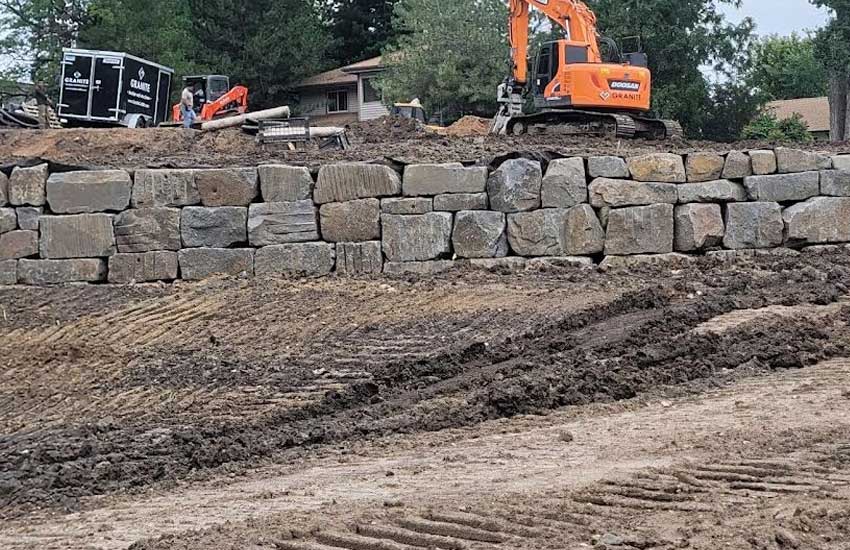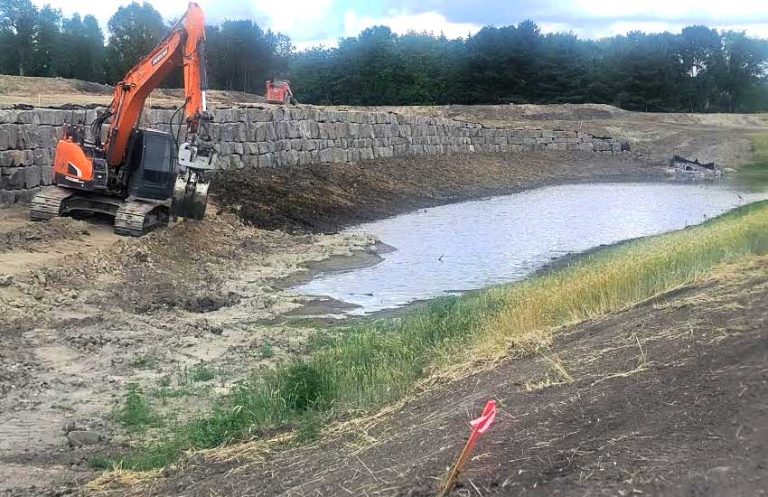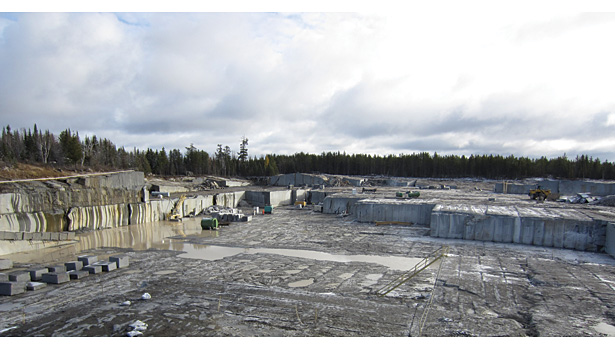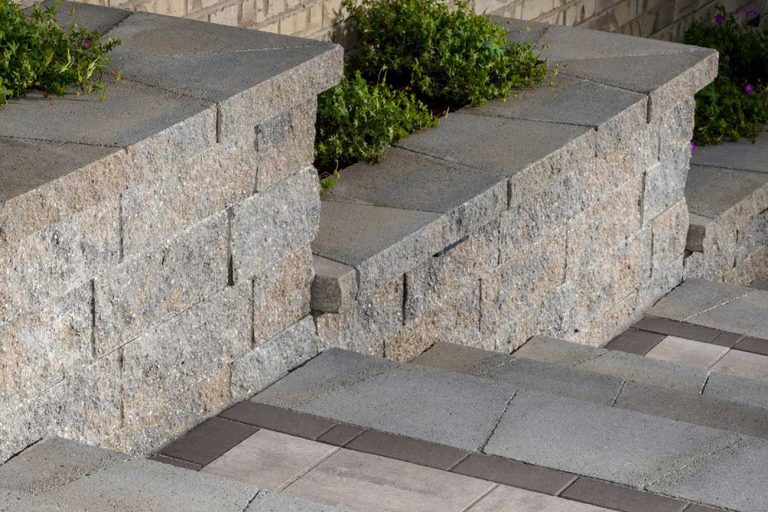Stone Materials for Retaining Walls
You might not be aware that the choice of stone for your retaining wall can significantly influence not only the aesthetics but also the structural integrity of your landscape. Among the myriad options, granite is highly celebrated for its robustness and ability to withstand severe weather conditions, but its higher cost might lead you to consider alternatives like limestone or sandstone, each with their unique benefits and challenges. As you weigh the pros and cons of each stone type—considering factors such as durability, cost, and visual appeal—you’ll find that the decision isn’t just about picking a stone, but about crafting the character and functionality of your outdoor space. What factors should you prioritize in your selection?
Granite: Unmatched Durability
Although granite is often more expensive, its unparalleled durability makes it an excellent choice for retaining walls. You’re not just buying stone; you’re investing in a legacy of strength that will stand the test of time. Granite’s robust composition, primarily quartz, mica, and feldspar, ensures that it can withstand severe weather conditions and heavy loads, critical factors for structures like retaining walls which face constant soil pressure.
Granite also boasts a low absorption rate, which means it resists weathering and maintains its integrity against freeze-thaw cycles. This characteristic is particularly significant if you’re in a region with harsh winters. You won’t have to worry about the stone cracking or splitting, a common issue with lesser materials. This resilience translates to reduced maintenance costs over time—a vital consideration for any long-term investment.
Moreover, the density of granite provides excellent sound barrier properties, reducing noise pollution and creating a serene outdoor environment. This can be a subtle yet powerful way to enhance the sense of tranquility in your community or backyard.
Choosing granite for your retaining wall isn’t just a practical decision; it’s a commitment to quality and enduring beauty that makes a definitive statement about the value you place on longevity and sustainability in construction.

Limestone: Classic Elegance
While granite offers robust durability, limestone brings its own appeal with a timeless elegance ideal for creating visually appealing retaining walls. You’ll find that limestone, primarily composed of calcite, boasts a natural beauty that integrates seamlessly into various landscape designs. Its subtle color palette—ranging from creamy whites to rich, earthy tans—enhances the aesthetic harmony of your outdoor space, making it a favorite among homeowners looking to create a welcoming atmosphere.
Limestone’s versatility extends beyond its looks. It’s also functional in its ability to withstand freeze-thaw cycles, crucial for outdoor structures. Its porosity allows it to manage water effectively, reducing the risk of water damage to the wall. However, it’s essential you’re aware that limestone requires sealing to prevent erosion and maintain its structural integrity over time.
When considering limestone for your retaining wall, you’re choosing a material that not only supports the soil but also contributes to a cohesive community feel. Its classic elegance invites a sense of history and durability, reminiscent of ancient structures that have stood the test of time. By selecting limestone, you’re not just building a wall; you’re embracing a tradition of enduring beauty that will be appreciated by your community for generations.
Sandstone: Natural Warmth
CURRENT SUBTOPIC: ‘Sandstone: Natural Warmth’
Sandstone stands out for its inherent warmth and rich, varied color palette, making it an ideal choice for retaining walls that blend naturally with your landscape. You’ll find that sandstone not only provides a robust physical barrier but also enhances the aesthetic cohesion between your garden and the natural surroundings. Its durability and ease of installation make it a practical choice for your landscaping projects.
Here’s a quick look at some key attributes of sandstone:
| Attribute | Description |
|---|---|
| Color Variation | Ranges from beige to red, adapting to various settings |
| Weather Resistance | Withstands varying climates with minimal erosion |
| Maintenance | Requires occasional cleaning to prevent moss build-up |
Sandstone’s porous nature allows it to absorb water, reducing runoff and promoting soil stability behind the wall. This feature is particularly valuable in areas susceptible to heavy rainfall. Analyzing its geological composition, sandstone consists mainly of quartz and feldspar, which contribute to its strength and weather-resistance capabilities.
Slate: Unique Textural Appeal
Slate’s distinct texture and durability make it a superior choice for creating visually striking and long-lasting retaining walls. As you consider the materials for your project, it’s important to recognize slate’s unique properties. This fine-grained metamorphic rock not only offers a plethora of natural color variations—from deep blues to earthy greens—but also provides a remarkably flat surface that makes stacking and installation less cumbersome than you might find with other natural stones.
The density and toughness of slate contribute significantly to its longevity. It resists weathering and maintains its integrity against the pressures exerted by soil and water, a crucial feature for retaining walls. This means you’re investing in a structure that stands firm and functional for years, minimizing future maintenance costs.
Moreover, slate’s cleavage abilities allow it to be split into sheets efficiently. This characteristic ensures precise, uniform layers that are aesthetically pleasing and structurally sound. When you choose slate, you’re not just building a wall; you’re crafting a community landmark that resonates with the area’s natural landscape, enhancing both the environment and your property’s value.
Fieldstone: Organic Aesthetics
Fieldstone introduces a naturally rugged charm to retaining walls, embodying an organic aesthetic that blends seamlessly with any landscape. You’ll find that fieldstone offers a distinct advantage in its variability in shape and color, which ensures no two walls are exactly alike. This uniqueness fosters a sense of individuality and connection to the natural world around your home.
When you choose fieldstone, you’re opting for durability and a timeless appearance. The stones themselves are sourced directly from the upper soil layer, making them inherently sturdy against weathering and erosion. This resilience makes fieldstone an ideal choice for not only aesthetic appeal but also long-term structural integrity.
In terms of installation, fieldstone can be more labor-intensive than some other materials due to its irregular shapes. However, this also allows for a highly customizable wall, as each stone must be carefully selected and placed. The end result is a one-of-a-kind structure that resonates with the landscape’s natural contours.
Moreover, the thermal mass properties of fieldstone contribute to energy efficiency, maintaining temperature stability within the retained soil. This aspect is particularly beneficial for plant life near the wall, enhancing growth conditions by moderating soil temperature fluctuations.
Gabion: Modern Versatility
While fieldstone offers a traditional appeal, gabion baskets provide a modern and versatile alternative for constructing retaining walls. You’ll find that gabion walls, composed of steel wire mesh filled with stones, not only serve as robust structural elements but also integrate seamlessly into various aesthetic contexts.
Gabion walls offer excellent drainage, making them ideal for areas prone to water runoff. The open structure of the mesh allows water to pass through, preventing the build-up of hydrostatic pressure behind the wall. This feature significantly reduces the risk of structural failure due to water-related issues.
Moreover, the flexibility of gabion walls is unparalleled. They can adapt to ground movement without losing integrity, which is crucial in areas with unstable soil. This adaptability extends to installation as well; you can shape gabion walls to fit the specific contours of your site, a distinct advantage over more rigid materials.
Environmentally, gabions score high. The stones used are typically local, reducing transportation emissions, and the structure itself promotes natural plant growth, which can enhance both the ecological value and the visual appeal of the wall.
Concrete Blocks: Engineered Strength
Moving from the adaptability of gabion walls, consider concrete blocks, which offer engineered strength for more demanding structural requirements. As you explore options for your retaining wall, it’s crucial to understand why concrete blocks might be the perfect fit for your project. Not only do they provide robust stability, but their manufactured precision ensures consistent quality and performance.
Concrete blocks are tailored to meet specific structural demands, making them a reliable choice for soil retention and landscape shaping. Here’s a deeper look into their significance:
- Uniformity: Each block is produced to exact specifications, ensuring uniformity in size and weight, which simplifies installation and enhances structural integrity.
- Durability: These blocks are resistant to weathering, chemicals, and frost, ensuring long-term durability, even under harsh environmental conditions.
- Flexibility in Design: Modular concrete blocks allow for flexibility in design, accommodating curves and corners with ease, promoting a sense of inclusion in various project scopes.
- Cost-Effective: They offer a cost-effective solution due to their long lifespan and minimal maintenance requirements.
- Eco-Friendly Options: Many concrete blocks contain recycled materials, reducing environmental impact and fostering a sense of community responsibility.
Choosing concrete blocks means investing in a sustainable, strong, and reliable retaining wall system that will serve you well into the future.
Brick: Timeless Charm
When you choose brick for your retaining wall, you’re selecting a material known for its aesthetic versatility; it blends seamlessly with various architectural styles and landscape designs.
Its durability is proven, offering long-term stability and resistance to weather conditions when properly maintained.
You’ll find that ongoing maintenance demands are manageable, primarily involving periodic inspections and occasional mortar joint repairs.
Aesthetic Versatility
Brick, with its timeless charm, offers remarkable aesthetic versatility, enabling you to match various architectural styles seamlessly. As you consider brick for your retaining walls, you’ll find its adaptability to various design narratives quite compelling. Here’s how brick can integrate into your project:
- Color Variety: From traditional reds to muted grays, brick provides a palette to complement any setting.
- Texture Options: Smooth, sand-faced, or rustic, each texture contributes uniquely to the visual complexity.
- Bond Patterns: Staggered, stacked, or herringbone, patterns add dynamic character and depth.
- Customization: Cut or molded into different shapes, brick can achieve distinctive design details.
- Cultural Resonance: Often associated with heritage structures, it evokes a sense of history and belonging.
Durability and Maintenance
Beyond its visual appeal, brick excels in durability, requiring minimal maintenance over its lengthy lifespan. You’ll find that its resistance to weathering and decay stands out among stone materials. Brick doesn’t just withstand the elements; it maintains its integrity under stress from environmental pressures like freeze-thaw cycles and moisture exposure. This robustness means fewer repairs and replacements for you, preserving both your budget and the wall’s aesthetic.
Moreover, the natural aging process of brick enhances its character without compromising structural strength. This enduring resilience fosters a sense of permanence and reliability, making you part of a community that values longevity and tradition in construction. Opting for brick not only connects you to a rich history but also ensures you’re building for the future.



